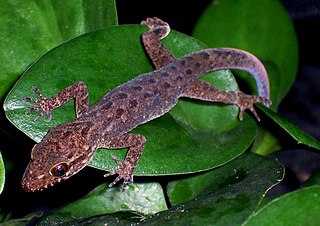
Hemidactylus is a genus of the common gecko family, Gekkonidae. It has 168 described species, newfound ones being described every few years. These geckos are found in all the tropical regions of the world, extending into the subtropical parts of Africa and Europe. They excel in colonizing oceanic islands by rafting on flotsam, and are for example found across most of Polynesia. In some archipelagoes, cryptic species complexes are found. Geckos like to live in and out of houses. They have been introduced to Australia.

Cyrtodactylus is a diverse genus of Asian geckos, commonly known as bent-toed geckos or bow-fingered geckos. It has at least 250 described species at present, which makes it the largest of all gecko genera.
Cyrtodactylus bidoupimontis is a gecko from Binh Phuoc and Lam Dong provinces, southern Vietnam.
Hemidactylus paucituberculatus is a species of house geckos from Oman.
Hemidactylus endophis is a species of house gecko from Oman.
Hemidactylus masirahensis is a species of house gecko. It is endemic to Masirah Island, off the coast of central Oman.
Hemidactylus festivus is a species of house gecko from Oman.
Hemidactylus alkiyumii is a species of house gecko from Oman.
Hemidactylus hajarensis is a species of house gecko from Oman.
Hemidactylus luqueorum is a species of house gecko endemic to Oman. The specific epithet luqueorum honors Maria Teresa Luque and her family.
Hemidactylus awashensis is a species of house gecko from Ethiopia. It grows to 54.8 mm (2.16 in) in snout–vent length.
Hemidactylus mandebensis is a species of house gecko from Yemen. It grows to 42 mm (1.7 in) in snout–vent length. It is a relatively small-sized member of the Hemidactylus robustus species group.
Hemidactylus adensis is a species of house gecko from Yemen. It grows to 41.8 mm (1.65 in) in snout–vent length.
Hemidactylus lopezjuradoi is a species of gecko, a lizard in the family Gekkonidae. The species is endemic to the Cape Verde Islands.
Hemidactylus bouvieri, also known as Bouvier's leaf-toed gecko or Cape Verde leaf-toed gecko, is a species of gecko in the family Gekkonidae. The species is endemic to the Cape Verde Islands and is listed as critically endangered. It has been found on the islands of São Vicente, Santo Antão, Santa Luzia, São Nicolau, Santiago and Ilhéu Raso.

Dutta’s Mahendragiri gecko is a species of large gecko found in Andhra Pradesh in India.
Hemidactylus graniticolus is a cryptic rock-dwelling species of large gecko found in India. The holotype was described from hills near Harohalli village in the Bangalore Rural District, Karnataka.
Hemidactylus boavistensis, the Boa Vista leaf-toed gecko, is a species of gecko in the family Gekkonidae. The species is endemic to the Cape Verde Islands. The specific name, boavistensis, refers to the island Boa Vista, one of the islands where it has been found. It has also been found on the island Sal and the islets of Curral Velho and Sal Rei. It had long been considered a subspecies of Hemidactylus bouvieri but was re-elevated as a separate species in 2008.
Treutler's gecko is a species of lizard in the family Gekkonidae. The species is endemic to India.
Asaccus margaritae, or Margarita's leaf-toed gecko, is a species of lizard in the family Phyllodactylidae. It is endemic to the Arabian Peninsula and occurs in the United Arab Emirates and Oman. It was first described in 2016.


